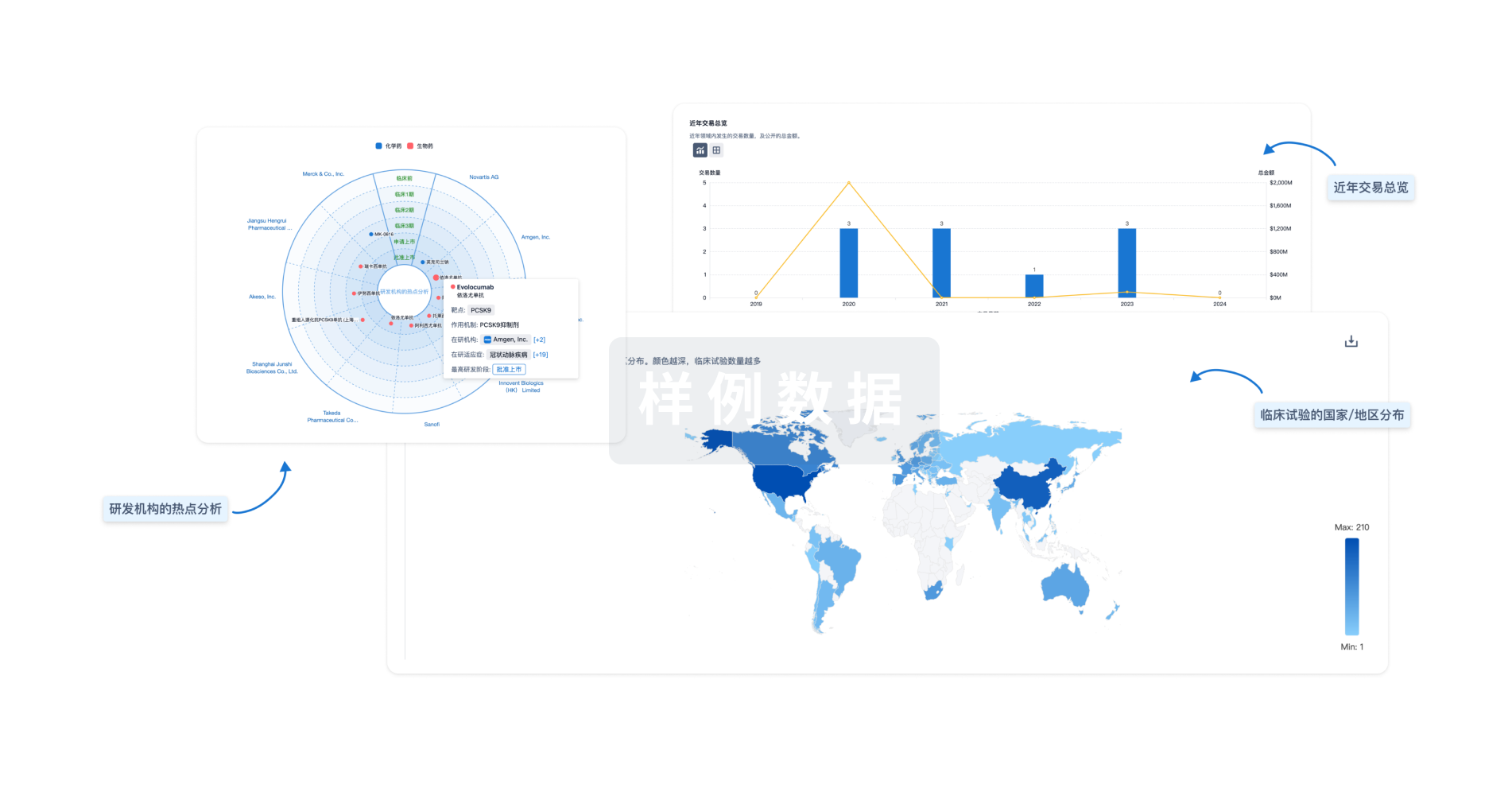预约演示
更新于:2025-05-07
APOA5
更新于:2025-05-07
基本信息
别名 Apo-AV、APOA-V、APOA5 + [4] |
简介 Minor apolipoprotein mainly associated with HDL and to a lesser extent with VLDL. May also be associated with chylomicrons. Important determinant of plasma triglyceride (TG) levels by both being a potent stimulator of apo-CII lipoprotein lipase (LPL) TG hydrolysis and an inhibitor of the hepatic VLDL-TG production rate (without affecting the VLDL-apoB production rate) (By similarity). Activates poorly lecithin:cholesterol acyltransferase (LCAT) and does not enhance efflux of cholesterol from macrophages. Binds heparin (PubMed:17326667). |
关联
100 项与 APOA5 相关的临床结果
登录后查看更多信息
100 项与 APOA5 相关的转化医学
登录后查看更多信息
0 项与 APOA5 相关的专利(医药)
登录后查看更多信息
1,466
项与 APOA5 相关的文献(医药)2025-07-01·Ophthalmology Science
Exploring the Causal Relationships between Lipid Biomarkers and Anti-VEGF Treatment Response in Patients with Neovascular Age-related Macular Degeneration
Article
作者: Liu, Xuemei ; He, Feixiang ; Chen, Yinglian ; Gu, Peilin ; Li, Chongyi ; Chen, Qifang ; Liu, Ting
2025-05-01·Nutrition, Metabolism and Cardiovascular Diseases
Effect of nut consumption on blood lipids: An updated systematic review and meta-analysis of randomized controlled trials
Review
作者: Garcia-Gavilán, Jesús F ; Salas-Salvadó, Jordi ; Ni, Jiaqi ; Paz-Graniel, Indira ; Valle-Hita, Cristina ; Khoury, Nadine ; Nishi, Stephanie K ; Babio, Nancy
2025-05-01·Genetics in Medicine
Pathogenicity assessment of genetic variants identified in patients with severe hypertriglyceridemia: Novel cases of familial chylomicronemia syndrome from the Dyslipidemia Registry of the Spanish Atherosclerosis Society
Article
作者: Arrobas-Velilla, Teresa ; Ariza, María José ; Ortega-Martínez de Victoria, Emilio ; Benítez-Toledo, María José ; Espíldora-Hernández, Javier ; Rioja, José ; Coca-Prieto, Inmaculada ; Muñiz-Grijalvo, Ovidio ; Casañas-Martínez, Marta ; Domènech, Mónica ; Delgado-Lista, Javier ; Sánchez-Chaparro, Miguel Ángel ; Sánchez-Gil, Justo ; González-Jiménez, Andrés ; León-Jiménez, David ; Blanco-Echevarría, Agustín ; Zambón-Rados, Daniel ; Gutiérrez-Carrasquilla, Liliana ; Valdivielso, Pedro ; Álvarez-Sala, Luis Antonio
14
项与 APOA5 相关的新闻(医药)2024-12-25
12月23日,BioBAY园内企业维亚臻的1类新药普乐司兰钠注射液(VSA001)拟纳入优先审评,在饮食控制基础上,用于降低家族性乳糜微粒血症综合征(FCS)成人患者的甘油三酯水平,进而减少急性胰腺炎的发生风险。
目前VSA001已在美国处于上市申请阶段,这也是针对载脂蛋白 C3(APOC3)靶点的全球首个申报上市的药物。
VSA001 是一款肝脏靶向的小干扰 RNA(siRNA)候选药物,通过高效且持久地沉默 APOC3 的 mRNA 水平,以降低 APOC3 蛋白的表达,进而通过脂蛋白脂酶依赖性和非依赖性双重途径,有效降低血清甘油三酯和富含甘油三酯的脂蛋白水平。
2024 年 6 月 25 日心血管和代谢产品管线研发网络会上,VSA001 在 FCS 成人患者中的关键3期 PALISADE 研究的最新结果被公布。
PALISADE 研究是一项随机、双盲、安慰剂对照的 III 期临床试验。该研究共纳入 75 名受试者(分布在 18 个国家的不同研究中心),随机接受每三个月一次的 VSA001 25 mg(26 例)、50 mg(24 例)或安慰剂(25 例)皮下注射治疗,持续 12 个月。完成随机期的受试者有资格继续参加扩展期研究。
PALISADE 研究的主要终点是第 10 个月经安慰剂校正中位甘油三酯(TG)水平变化。结果显示,接受 25 mg 或 50 mg VSA001 治疗的患者分别实现了中位甘油三酯水平减少 80% 和 78%。
除了达到主要终点外,VSA001 还达到了所有关键性次要终点,包括第 10 个月和第 12 个月(平均)空腹甘油三酯从基线的百分比变化;第 10 个月空腹 APOC3 从基线的百分比变化;第 12 个月空腹 APOC3 从基线的百分比变化;在随机对照研究期间急性胰腺炎事件的发生率。研究数据还显示每三个月一次给药的 VSA001 在整个研究期间持续降低甘油三酯水平(中位数和平均值),且变异性低。
在安全性方面,VSA001 在 PALISADE 研究中表现出良好的安全性。不良事件(AEs)的受试者数量在 VSA001 和安慰剂组中相似。重度和严重不良事件在 VSA001 组中比在安慰剂组中更少见。最多的不良事件是腹痛、新冠肺炎、鼻咽炎、头痛和恶心。
FCS 是一种严重的极罕见遗传疾病,据不完全统计其患病率约为 1/1,000,000,通常由多种单基因(例如 LPL、GPIHBP1、APOC2、APOA5 或 LMF1)功能缺失突变引起。FCS 通常导致空腹 TG 水平极度升高(880 mg/dL 以上),严重 TG 升高可导致多种临床疾病及严重并发症,包括动脉粥样硬化、急性胰腺炎、2 型糖尿病和肝脂肪变性等,目前尚无有效的治疗药物获批。VSA001 有望成为首个针对 FCS 的有效获批药物。
▌文章来源:医麦客
责编:赵家帅
审核:任旭
推荐阅读
研发动态丨第10款临床产品!信诺维PARG抑制剂IND获批
研发动态丨信诺维:新药福诺巴坦(XNW4107)提交Pre-NDA申请,为HABP/VABP患者带来新希望
研发动态丨爱科诺生物:宣布其RIPK2抑制剂AC-101获美国FDA批准开展二期临床试验
siRNA优先审批临床3期信使RNA
2024-12-24
12月23日,CDE官网显示,维亚臻生物的 1 类新药普乐司兰钠注射液拟纳入优先审评,适应症为:在饮食控制基础上,用于降低家族性乳糜微粒血症综合征(FCS)成人患者的甘油三酯水平,进而减少急性胰腺炎的发生风险。
据公开资料显示,普乐司兰钠注射液一款肝脏靶向的小干扰 RNA(siRNA)药物,通过高效且持久地沉默载脂蛋白 C3(APOC3)的 mRNA 水平,以降低 APOC3 蛋白的表达,进而通过脂蛋白脂酶依赖性和非依赖性双重途径,有效降低血清甘油三酯和富含甘油三酯的脂蛋白水平。
FCS 是一种严重的极罕见遗传疾病,据不完全统计其患病率约为 1/1,000,000,通常由多种单基因(例如 LPL、GPIHBP1、APOC2、APOA5 或 LMF1)功能缺失突变引起。FCS 通常导致空腹 TG 水平极度升高(880 mg/dL 以上),严重 TG 升高可导致多种临床疾病及严重并发症,包括动脉粥样硬化、急性胰腺炎、2 型糖尿病和肝脂肪变性等,目前尚无有效的治疗药物获批。
优先审批siRNA信使RNA寡核苷酸
2024-06-03
关注并星标CPHI制药在线
家族性乳糜微粒血症综合征(FCS),也被称为Ⅰ型原发性高脂蛋白血症(T1HLP)或脂蛋白脂肪酶缺乏症(LPLD),是一种罕见的常染色体隐性遗传疾病。FCS通常由多种单基因(如LPL、GPIHBP1、APOC2、APOA5或LMF1)的功能缺失突变或复合/双重杂合突变引起,从而使LPL的活性下降或功能缺失,导致血浆中乳糜微粒(CM)浓度升高和高三酰甘油血症(HTG)。乳糜微粒是肠细胞在吸收后状态下合成和分泌的富含TG的脂蛋白。
FCS多始于儿童期、青少年期或成年早期,主要临床特征包括急性发作性腹痛、乏力、皮肤黄色瘤、肝脾肿大、视网膜脂质症、反复发作急性胰腺炎(AP)及神经症状,如易怒、记忆丧失和抑郁,严重者影响患者的生活质量。
FCS治疗现状
FCS治疗目的包括降低发生胰腺炎的风险、减轻因血浆TG水平升高相关的短期临床症状。由于FCS患者缺乏分解代谢脂肪的能力,对标准降脂药物反应不佳。
目前,全球获批治疗FCS的药物有限,仅有Glybera(alipogene tiparvovec) 和Waylivra(volanesorsen)。其中Glybera(alipogene tiparvovec)是UniQure公司开发的一款AAV基因疗法,其以AAV为载体将治疗基因LPL转导入肌细胞,从而使相应的细胞能够产生一定数量的脂蛋白脂酶,起到缓解疾病的作用。2012年11月,Glybera在欧盟被批准用于治疗严格限制脂肪饮食却仍然发生严重或反复胰腺炎发作的FCS。但由于定价太高、市场需求受限等因素,2017年Glybera退市。
Waylivra是Akcea和Ionis公司联合开发的一款反义寡核苷酸(ASO)药物,旨在减少ApoC-III的产生(ApoC-III是载脂蛋白C家族中含量最丰富的一类,主要在肝脏中合成,是血清TG的关键调节因子),2019年5月在欧盟被批准辅助饮食控制,用于治疗对饮食控制和降甘油三酯疗法一直控制不佳、存在胰腺炎高风险的成人FCS。
已公布的Waylivra针对FCS的3期临床试验APPROACH(NCT02211209)数据显示:与安慰剂相比,volanesorsen能显著降低FCS患者的甘油三酯(TG)水平(76.5% Vs 17.6%)。
除了获批治疗FCS,Waylivra在巴西还被批准用于治疗家族性部分脂肪营养不良(FPL),成为全球首个获批治疗FPL的药物。不过,Waylivra在美国进展不顺,FDA处于安全性考虑,曾拒绝批准其治疗FCS。
在研FCS药物研究进展
据不完全统计,目前全球还有几款在研FCS新疗法,详见下表。这几款药物均作用于apoC-III,且部分药物进入临床后期。
全球部分在研FCS疗法
资料来源:公开资料
Olezarsen:3期临床成功,即将申请上市
Olezarsen是一种新型N-乙酰半乳糖胺(GalNAc)结合的反义寡核苷酸,靶向肝脏APOC III mRNA,选择性地抑制APOC III的合成。2023年1月,该药被FDA授予治疗FCS的快速通道资格。
2023年9月,Ionis公司宣布Olezarsen治疗FCS的3期临床试验Balance取得积极结果,达到主要疗效终点,能够显著改善患者的甘油三酯水平,同时展现出良好的安全性和耐受性。Balance试验是一项全球、多中心、随机、双盲、安慰剂对照研究,共入组66例成人FCS患者,研究中患者按1:1:1比例随机皮下注射50、80mg Olezarsen或者安慰剂,每4周1次,持续53周。
研究数据显示:6个月时,80mg Olezarsen治疗组患者的甘油三酯水平较安慰剂组显著降低(p=0.0009);12个月时,80mg Olezarsen治疗组患者的甘油三酯水平持续改善。而且,与安慰剂相比,80mg Olezarsen治疗组患者急性胰腺炎事件减少了100%(Olezarsen组0例,安慰剂组11例)。接受Olezarsen 80mg治疗后,apoC-III也减少75%以上。不过,50mg Olezarsen治疗组在降低甘油三酯的主要终点方面并未达到统计学显著性。
基于该研究结果,Ionis公司计划于2024年向FDA以及欧盟提交Olezarsen 治疗FCS的新药申请。
ARO-APOC3:获FDA通道资格,可3个月给药一次
ARO-APOC3是一种皮下给药、靶向ApoC-III的小干扰RNA(siRNA)药物,通过特异性靶向和沉默APOC-III mRNA,减少肝脏内apoC-III的生成,使VLDL和乳糜微粒残留物更好地清除。2019年7月,ARO-APOC3被FDA授予治疗FCS的孤儿药资格。2023年3月,该疗法又被FDA授予快速通道资格,用于降低FCS成年患者的甘油三酯。
2021年AHA(美国心脏协会)上公布的1/2期临床试验数据显示:在FCS患者中,ARO-APOC3可将甘油三酯水平降低91%。目前,该药针对FCS的3期临床试验PALISADE正在进行,关键数据今年上半年有望读出。此外,该药还有一个很大优势,给药间隔比较长,只需每3个月或6个月打一针,就可以有效控制血脂。
VSA001:中国3期临床试验完成入组
VSA001是靶向ApoC-III的siRNA药物,2023年9月被CDE纳入突破性治疗品种,用于降低FCS成人患者的甘油三酯水平。2024年1月,维亚臻宣布VSA001已顺利完成中国FCS 3期临床试验超过36例全部患者入组,并计划于2025年第一季度完成该临床试验的全部终点评价,以支持后续的新药注册上市申请。
不过考虑到维亚臻是由Arrowhead与维梧资本联合创立,且与Arrowhead建立了长期合作关系。笔者推测VSA001可能就是从Arrowhead引进的ARO-APOC3。
RBD5044:我国药企研发,1期试验已启动
RBD5044基于瑞博生物RIBO-GalSTAR? 肝靶向递送技术开发的一款旨在治疗高甘油三酯血症的GalNAc缀合siRNA药物,可以抑制肝细胞ApoC-III表达,上调脂蛋白脂肪酶和肝细胞受体介导的残余颗粒摄取,促进富甘油三酯脂蛋白(TRLs)上甘油三酯(TGs)的水解,实现降低血液中TG水平的目标。
非临床安全性和有效性研究数据显示,RBD5044具有潜在同类领先的有效性和较长药效持续时间。2022年11月,RBD5044在澳大利亚的首次人体临床试验启动。
总结
作为一种罕见病,家族性乳糜微粒血症综合征(FCS)治疗领域几近空白,曾获批的Glybera因定价高等因素撤市,Waylivra仅在部分国家和地区获批上市。FDA因Waylivra在临床试验中存在血小板减少和出血相关的安全性,拒绝批准其上市申请。不过,罕见病虽然患者群体相对较小,但药企并未放弃FCS领域新药的研发。
在研FCS药物几乎均作用于ApoC-III靶点,其中Olezarsen进展最快,3期临床已取得积极结果,预计今年将申请上市。此外,罕见病药物大多定价太高,如何惠及更多罕见病患者也是药企和监管部门需要考虑的点。
【企业推荐】
来源:CPHI制药在线
声明:本文仅代表作者观点,并不代表制药在线立场。本网站内容仅出于传递更多信息之目的。如需转载,请务必注明文章来源和作者。
投稿邮箱:Kelly.Xiao@imsinoexpo.com
▼更多制药资讯,请关注CPHI制药在线▼
点击阅读原文,进入智药研习社~
临床3期基因疗法上市批准寡核苷酸
分析
对领域进行一次全面的分析。
登录
或

生物医药百科问答
全新生物医药AI Agent 覆盖科研全链路,让突破性发现快人一步
立即开始免费试用!
智慧芽新药情报库是智慧芽专为生命科学人士构建的基于AI的创新药情报平台,助您全方位提升您的研发与决策效率。
立即开始数据试用!
智慧芽新药库数据也通过智慧芽数据服务平台,以API或者数据包形式对外开放,助您更加充分利用智慧芽新药情报信息。
生物序列数据库
生物药研发创新
免费使用
化学结构数据库
小分子化药研发创新
免费使用